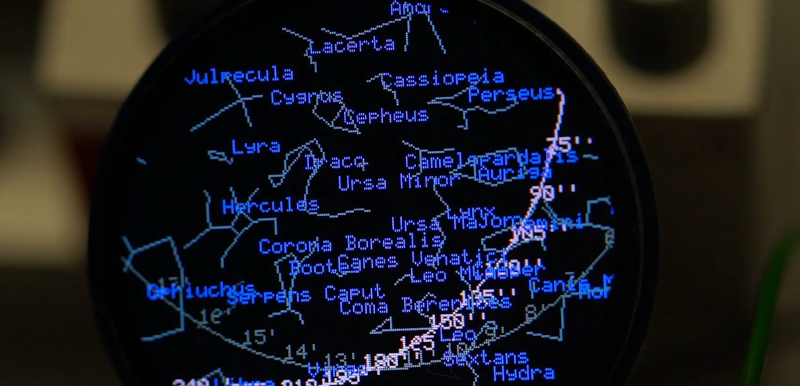We always look at the round LCDs and wonder what to do with them other than, of course, a clock. Well, [shabaz] had a great idea: use it as a star map display. The project combines the Arduino, a round TFT, a GPS receiver, and some external flash memory to store data. You can get by without the GPS receiver or flash memory, but you’ll lose features if you do.
We like how he approached the problem. The project contains four major parts and he developed each part independently before integrating them into a whole. The four parts are: reading the GPS, driving the LCD, providing storage for star data, and determining the position of stars. The heavy lifting is done using some public domain code ported over. This code derives from a book called Astronomical Algorithms and uses the Yale Bright Star Catalog database.
The post mentions that the screen might well be a larger rectangular screen and we agree that would make this more usable. Now if you could cram it all into a watch, that might be different. If you want to play with the code, you can actually run the core on Linux. You’ll have to settle for a PNG output of the night sky, but that would be handy for debugging.
We have seen a star chart in a watch before. While this is more a star chart than a planetarium, we have no doubt the early planetarium builders would be suitably impressed.
















I was thinking about using round LCDs as guages in a dashboard.
Beautiful! 🖤 Brings back memories of admiring Sky Globe on a 486 PC (DOS/SVGA) !
Agreed, that was a wonderful program.
I was able to run Sky Globe at STM32 (in 80186 emulator): https://hackaday.io/project/153287/gallery#128e7fa3c63f1f8dd4e28b4ccddc5677
Reminds me of the old DOS program Skyglobe. I used it quite a lot to check for stars and planet locations.
Should use shades of red for display, then it could be used in the field while stargazing without messing up night vision.
Might need a red filter over the screen in case of backlight leakage or wonky pixels.
For night vision you actually want the dimmest possible light that you can read, and that is green. Red is actually bad advice from before people actually researched it.
got a source for that?
Never really thought about it but spontaneously I’d say red light is good in this case because it leaves the green receptors un-excited (?) and thus they are more receptive/sensitive to what little green light comes from what you’re actually looking at.
Or red/green makes (almost) no difference because human night vision mostly uses the b/w-receptors (“Rods”, brightness) and not the “Cones” (colors) anyway?
how can we implement this project but instead using a UNO R3 2.8 TFT Touch Screen with SD Card Socket and a GY-GPS6MV2 GPS Control Module with an arduino uno?